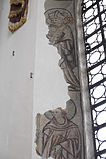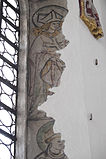St. Aegidius (Grafing)
The Catholic parish church of St. Egidius in Grafing near Munich ( district Oexing ), the largest city in the Upper Bavarian district of Ebersberg , was built in the 17th century on the foundation walls of a previous Gothic church. The remains of Gothic frescoes have been preserved in the choir . The church is consecrated to St. Aegidius .
history
The first church probably existed as early as the 9th century, as can be seen from a document in 813 on the occasion of a stay of Bishop Hitto von Freising in the settlement of Öxing, which is now in Grafing . Nothing of this church has survived. In the 11th century a Romanesque church was built, to which the foundations of a tower under today's south portal can be traced back. The church, which was considerably enlarged around 1500, was set on fire by Swedish troops during the Thirty Years' War in 1632 and completely destroyed by an earthquake in 1690.
In 1692 the church was rebuilt in the Baroque style . In 1903/04 the church was extended to the west and a lower church was built to compensate for the difference in level.
architecture
On the south side of the choir rises the 41 meter high tower with its octagonal structure and its onion dome . The church is a hall , the nave of which is divided into six bays . A wide choir arch opens up to the drawn-in, three-sided closed choir.
The needle cap barrel is decorated with fine stucco in the Rococo style. The frescoes, surrounded by stucco frames, were created by Jacques Dasbourg in 1915.
Gothic frescoes in the choir
In the frame of the central choir window and on the walls of the choir, remains of Gothic frescoes have been preserved. Bishops are depicted in the window frame, heads can be seen on the other fragments.
Furnishing
- The furnishings are from 1775. The symbols of the evangelists (the winged person for Matthew, the lion for Mark, the bull for Luke and the eagle for John) are depicted on the pulpit .
- Numerous epitaphs from the 15th and 16th centuries are kept in the church.
organ
The organ of the parish church St. Agidius was built in 1935 by the company Willibald Siemann & Co. from Munich . The electro-pneumatic cone- loading instrument comprises a total of 33 sounding stops on three manuals and a pedal . The disposition is as follows:
|
|
|
|
|||||||||||||||||||||||||||||||||||||||||||||||||||||||||||||||||||||||||||||||||||||||||||||||||||||||||||||||||||||||||||||||||||||||||||||||||||||||||||||||||||||
- Pair : II / I, III / I, Super III / I, III / II, Super III / II, I / P, II / P, III / P
- Playing aids : crescendo kick , swell kick , 2 free combinations , tutti , crescendo off, tongues off, aut. Pedal off
literature
- Georg Dehio : Handbook of German Art Monuments - Bavaria IV - Munich and Upper Bavaria . 2nd Edition. Deutscher Kunstverlag, Munich 2002, ISBN 3-422-03010-7 , p. 367-368 .
Web links
Coordinates: 48 ° 2 ′ 49 ″ N , 11 ° 58 ′ 8.9 ″ E






